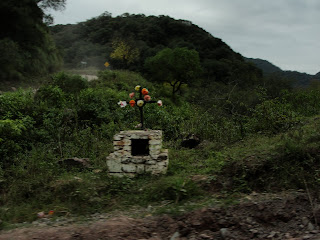Passing through four layers of forest in a very short stretch of land (a 2000m ascent in just 20km at one point) took us through amazing scenery.

probably such an insult to the Incas... oh well
At 65,000 hectares Parque Nacional Los Cardones is the second largest park in Argentina. It was established less than 15 years ago and a handful of farmers still live in the park farming and helping the park wardens protect the land. Hunting is not allowed, so if a puma or condor eats someone's cattle the park is obligated to reimburse the farmer for money lost. The local guanacos are endangered so they've started placing slower and more prevalent donkeys as "bait" for the pumas... Not sure how well that's working out for the endangered species. Not great for the donkeys, obviously.
This park has 22km of the straightest road I have seen since driving through Kansas years ago.

The park also has miles and miles of cardon cactus.

We stopped in Cachi for lunch.
Cachi's main plaza
There's not much to Cachi other than a small main plaza, some cafes, a nice church with rafters built from cardon, a crazy Suiss guy who has built a UFO landing strip in town (Cachi is apparently a UFO hotspot) and a LOT of dust and wind.

On the way back the clouds had dropped and the scenery had changed dramatically. Still totally beautiful though.
the highest point we would reach that day
Monuments are scattered all along the roadside, and we learned about the tradition of the apacheta (which I had heard of in Peru but not in this way): when someone dies, a monument is built in that space and instead of (or sometimes in addition to) flowers people place things that person liked to eat, to help sustain them in their next life. So it wouldn't be surprising to find a bowl of chicken soup in an apacheta... As long as the stray dogs didn't get to it first!
Very early start the next day so we crashed shortly after dinner. Dinner, by the way, involved roast beef pizza... who knew?















No comments:
Post a Comment